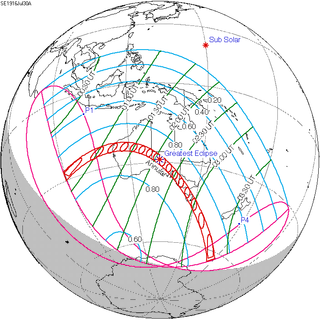| Solar eclipse of July 30, 1916 | |
|---|---|
 | |
| Type of eclipse | |
| Nature | Annular |
| Gamma | −0.7709 |
| Magnitude | 0.9447 |
| Maximum eclipse | |
| Duration | 384 s (6 min 24 s) |
| Coordinates | 29°00′S 132°24′E / 29°S 132.4°E |
| Max. width of band | 313 km (194 mi) |
| Times (UTC) | |
| Greatest eclipse | 2:06:10 |
| References | |
| Saros | 144 (11 of 70) |
| Catalog # (SE5000) | 9318 |
An annular solar eclipse occurred at the Moon's descending node of orbit on Sunday, July 30, 1916,[1][2][3] with a magnitude of 0.9447. A solar eclipse occurs when the Moon passes between Earth and the Sun, thereby totally or partly obscuring the image of the Sun for a viewer on Earth. An annular solar eclipse occurs when the Moon's apparent diameter is smaller than the Sun's, blocking most of the Sun's light and causing the Sun to look like an annulus (ring). An annular eclipse appears as a partial eclipse over a region of the Earth thousands of kilometres wide. Occurring 1.75 days after apogee (on July 28, 1916, at 8:30 UTC), the Moon's apparent diameter was smaller.[4]
Annularity was visible from only one country, Australia. A partial eclipse was visible for parts of Southeast Asia, Australia, Oceania, and Antarctica.
- ^ "July 29–30, 1916 Annular Solar Eclipse". timeanddate. Retrieved 1 August 2024.
- ^ "ECLIPSE OF THE SUN. A STRIKING SPECTACLE. CROWDS USE SMOKED GLASS. WORK IN OBSERVATORY". The Age. Melbourne, Victoria, Victoria, Australia. 1916-07-31. p. 8. Retrieved 2023-12-02 – via Newspapers.com.
- ^ "SOLAR ECLIPSE. SPLENDID VIEW IN SYDNEY". The Sydney Morning Herald. Sydney, New South Wales, New South Wales, Australia. 1916-07-31. p. 8. Retrieved 2023-12-02 – via Newspapers.com.
- ^ "Moon Distances for London, United Kingdom, England". timeanddate. Retrieved 1 August 2024.
